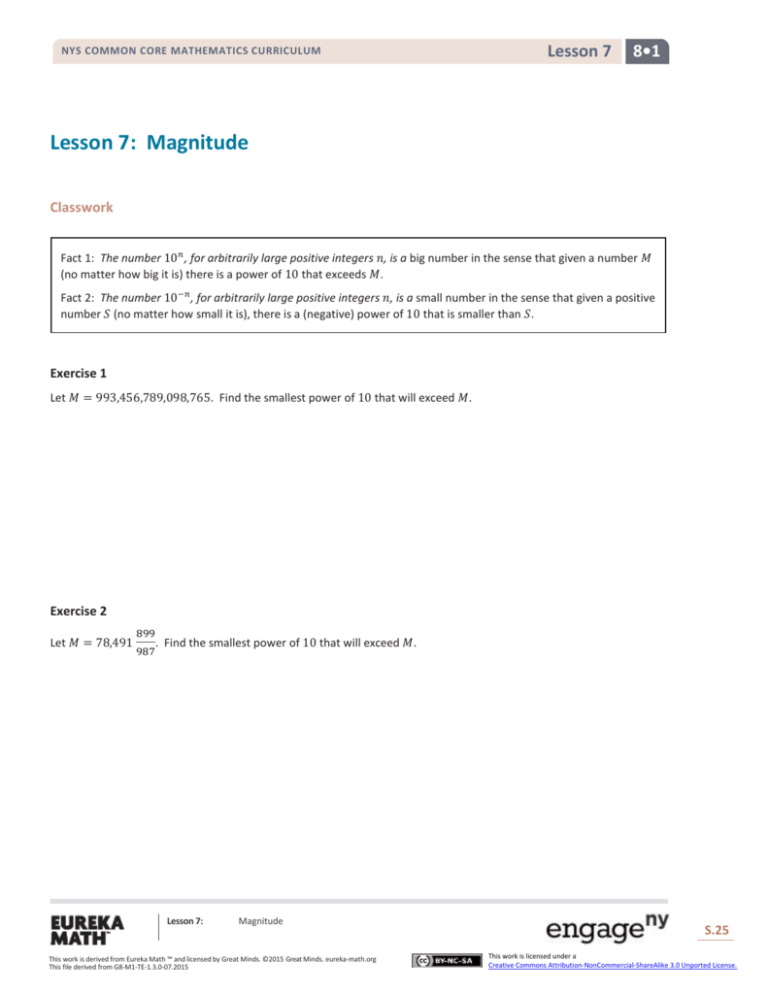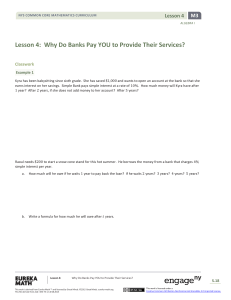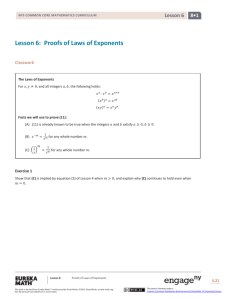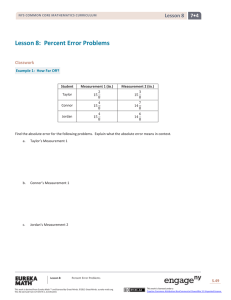Grade 8 Mathematics Module 1, Topic B, Lesson 7
advertisement

NYS COMMON CORE MATHEMATICS CURRICULUM Lesson 7 8•1 Lesson 7: Magnitude Classwork Fact 1: The number 10𝑛 , for arbitrarily large positive integers 𝑛, is a big number in the sense that given a number 𝑀 (no matter how big it is) there is a power of 10 that exceeds 𝑀. Fact 2: The number 10−𝑛 , for arbitrarily large positive integers 𝑛, is a small number in the sense that given a positive number 𝑆 (no matter how small it is), there is a (negative) power of 10 that is smaller than 𝑆. Exercise 1 Let 𝑀 = 993,456,789,098,765. Find the smallest power of 10 that will exceed 𝑀. Exercise 2 Let 𝑀 = 78,491 899 987 . Find the smallest power of 10 that will exceed 𝑀. Lesson 7: Magnitude This work is derived from Eureka Math ™ and licensed by Great Minds. ©2015 Great Minds. eureka-math.org This file derived from G8-M1-TE-1.3.0-07.2015 S.25 This work is licensed under a Creative Commons Attribution-NonCommercial-ShareAlike 3.0 Unported License. Lesson 7 NYS COMMON CORE MATHEMATICS CURRICULUM 8•1 Exercise 3 Let 𝑀 be a positive integer. Explain how to find the smallest power of 10 that exceeds it. Exercise 4 The chance of you having the same DNA as another person (other than an identical twin) is approximately 1 in 10 trillion (one trillion is a 1 followed by 12 zeros). Given the fraction, express this very small number using a negative power of 10. 1 10 000 000 000 000 Exercise 5 The chance of winning a big lottery prize is about 10−8 , and the chance of being struck by lightning in the U.S. in any given year is about 0.000 001. Which do you have a greater chance of experiencing? Explain. Exercise 6 There are about 100 million smartphones in the U.S. Your teacher has one smartphone. What share of U.S. smartphones does your teacher have? Express your answer using a negative power of 10. Lesson 7: Magnitude This work is derived from Eureka Math ™ and licensed by Great Minds. ©2015 Great Minds. eureka-math.org This file derived from G8-M1-TE-1.3.0-07.2015 S.26 This work is licensed under a Creative Commons Attribution-NonCommercial-ShareAlike 3.0 Unported License. Lesson 7 NYS COMMON CORE MATHEMATICS CURRICULUM 8•1 Problem Set 1. What is the smallest power of 10 that would exceed 987,654,321,098,765,432? 2. What is the smallest power of 10 that would exceed 999,999,999,991? 3. Which number is equivalent to 0.000 000 1: 107 or 10−7 ? How do you know? 4. Sarah said that 0.000 01 is bigger than 0.001 because the first number has more digits to the right of the decimal point. Is Sarah correct? Explain your thinking using negative powers of 10 and the number line. 5. Order the following numbers from least to greatest: 105 Lesson 7: 10−99 10−17 1014 Magnitude This work is derived from Eureka Math ™ and licensed by Great Minds. ©2015 Great Minds. eureka-math.org This file derived from G8-M1-TE-1.3.0-07.2015 10−5 1030 S.27 This work is licensed under a Creative Commons Attribution-NonCommercial-ShareAlike 3.0 Unported License.











